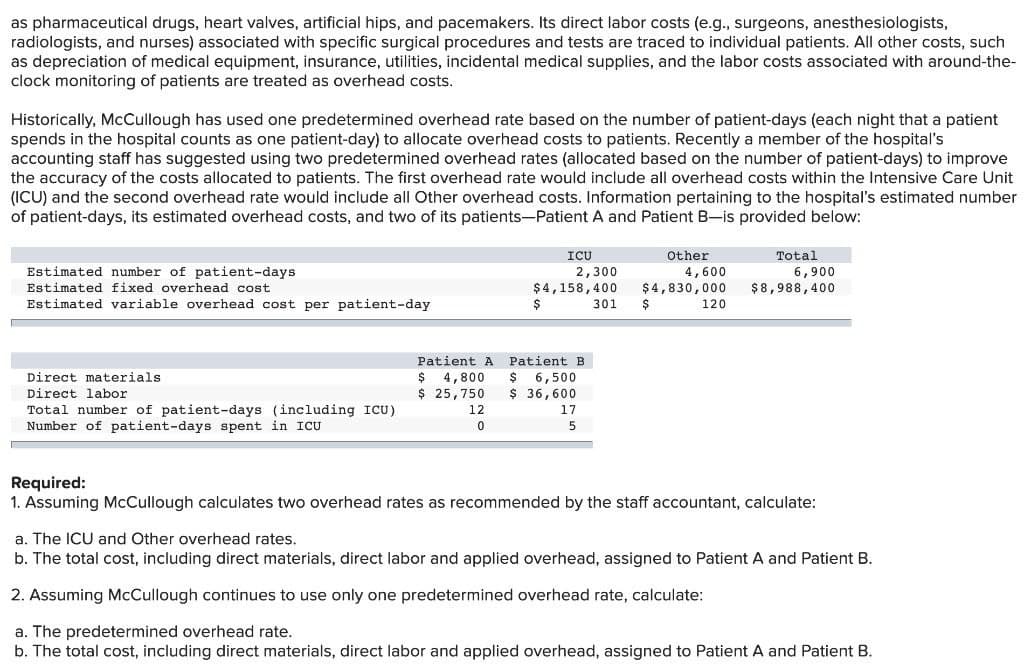as pharmaceutical drugs, heart valves, artificial hips, and pacemakers. Its direct labor costs (e.g., surgeons, anesthesiologists, radiologists, and nurses) associated with specific surgical procedures and tests are traced to individual patients. All other costs, such as depreciation of medical equipment, insurance, utilities, incidental medical supplies, and the labor costs associated with around-the- clock monitoring of patients are treated as overhead costs. Historically, McCullough has used one predetermined overhead rate based on the number of patient-days (each night that a patient spends in the hospital counts as one patient-day) to allocate overhead costs to patients. Recently a member of the hospital's accounting staff has suggested using two predetermined overhead rates (allocated based on the number of patient-days) to improve the accuracy of the costs allocated to patients. The first overhead rate would include all overhead costs within the Intensive Care Unit (ICU) and the second overhead rate would include all Other overhead costs. Information pertaining to the hospital's estimated number of patient-days, its estimated overhead costs, and two of its patients-Patient A and Patient B-is provided below: Estimated number of patient-days Estimated fixed overhead cost Estimated variable overhead cost per patient-day ICU 2,300 $4,158,400 Other 4,600 $4,830,000 Total 6,900 $8,988,400 $ 301 $ 120 Patient A Patient B Direct materials $ 4,800 Direct labor $ 25,750 Total number of patient-days (including ICU) 12 $ 6,500 $ 36,600 17 Number of patient-days spent in ICU 0 5 Required: 1. Assuming McCullough calculates two overhead rates as recommended by the staff accountant, calculate: a. The ICU and Other overhead rates. b. The total cost, including direct materials, direct labor and applied overhead, assigned to Patient A and Patient B. 2. Assuming McCullough continues to use only one predetermined overhead rate, calculate: a. The predetermined overhead rate. b. The total cost, including direct materials, direct labor and applied overhead, assigned to Patient A and Patient B.
Process Costing
Process costing is a sort of operation costing which is employed to determine the value of a product at each process or stage of producing process, applicable where goods produced from a series of continuous operations or procedure.
Job Costing
Job costing is adhesive costs of each and every job involved in the production processes. It is an accounting measure. It is a method which determines the cost of specific jobs, which are performed according to the consumer’s specifications. Job costing is possible only in businesses where the production is done as per the customer’s requirement. For example, some customers order to manufacture furniture as per their needs.
ABC Costing
Cost Accounting is a form of managerial accounting that helps the company in assessing the total variable cost so as to compute the cost of production. Cost accounting is generally used by the management so as to ensure better decision-making. In comparison to financial accounting, cost accounting has to follow a set standard ad can be used flexibly by the management as per their needs. The types of Cost Accounting include – Lean Accounting, Standard Costing, Marginal Costing and Activity Based Costing.

Step by step
Solved in 4 steps







